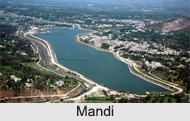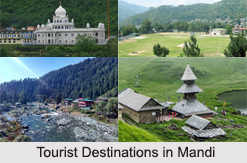 Mandi, which is also known as Sohor is a small hilly town in Himachal Pradesh. This small late medieval city of religious significance - Mandi is dotted with numerous temples and the holy lakes. Trekking to the holy lake is known as the Yatra among the Hindu. It is known as mini Varanasi.
Mandi, which is also known as Sohor is a small hilly town in Himachal Pradesh. This small late medieval city of religious significance - Mandi is dotted with numerous temples and the holy lakes. Trekking to the holy lake is known as the Yatra among the Hindu. It is known as mini Varanasi.
History of Mandi
The history of Varanasi of the Hills began with the rule of Bahu Sen in 1200 AD. Then it fell under the hands of Delhi Sultanate, Mughal Dynasty and later the British Empire in India.
Geography of Mandi
The ancient and modern Mandi in Mandi District is developed on the banks of the Beas River, at the confluence of the Suketi Khad stream. Sikandar Dhar, Ghugar Dhar and Dhar Kot are some of the prominent hills and mountains found near the city. The geographical extension of Mandi is about 31 degree 72 minutes North latitude and 76 degree 92 minutes East longitude.
Demography of Mandi
According to the Population Census in the year 2011, Mandi had a population of 26,858. The males in urban Mandi constitute 53 percent and females around 47 percent respectively.
Economy of Mandi
 Mandi is popular not only for the temples, that bears north Indian architecture, but also it acts as a gateway to Kullu District, Lahaul and Spiti District, Leh and Ladakh and some area of Jammu and Kashmir. The economy of the region is predominately agrarian as around 79 percent of the total population is dependent on agriculture and activities.
Mandi is popular not only for the temples, that bears north Indian architecture, but also it acts as a gateway to Kullu District, Lahaul and Spiti District, Leh and Ladakh and some area of Jammu and Kashmir. The economy of the region is predominately agrarian as around 79 percent of the total population is dependent on agriculture and activities.
Tourism in Mandi
The people of Mandi proudly boast that while Kashi (Benaras or Varanasi) has only 80 temples, Mandi has 81 temples. J.C. French supported his assertion when he described the town as a "Miniature Varanasi" with innumerable Hindu temples, medieval houses, mosques, Buddhist temples, gurdwara and the market place. The Sati pillars called barselas in the local dialect (Gharwali Language) are erected on the left bank of the Suketi Bridge. These stone pillars are 6 ft to 7ft. These stone pillars are erected in the memory of the rulers of Mandi. The eye-catching Chinese Pagoda (Chinese School for learning) of this town is the palace of the Raja of Mandi. Rewalsar Lake, a place of pilgrimage is located at a distance of 25 km from Mandi. The lake is dotted with seven huge masses of reeds, which give the appearance of small floating islands when the breeze is strong. There are three temples, a Buddhist monastery and a gurudwara (Sikh temple) located near the holy lake. Shyama Kali Temple is situated on a high ground is the most popular religious place of Mandi. It is also known as "Tarna Devi", one of the goddesses of Hindu mythology.
Visiting Information
The nearest airport is Bhuntar Airport, 63 km (flight from Delhi via Chandigarh). The nearest station is Kiratpur 125 km away. One need to come Mandi by roadway via Chandigarh (200 km), Pathankot (205 km), Shimla District (165 km), Kullu District (71 km), Delhi (465 km) and Manali (107 km).



















